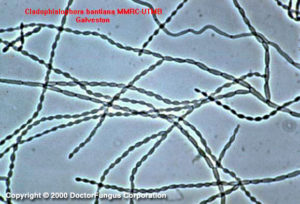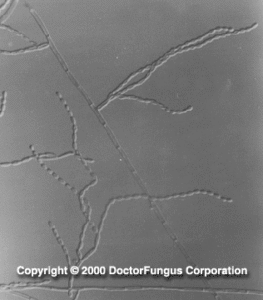Link ex Gray, 1821, de Hoog (1995)
Taxonomic classification
Kingdom: Fungi
Phylum: Ascomycota
Subphylum: Ascomycotina
Genus: Cladophialophora
Description and Natural Habitats
Cladophialophora is a mitosporic dematiaceous (pigmented) mould. Its natural habitats are soil and rotten plant material. Some species are predominant in tropical and subtropical regions [533, 602].
Species
The genus Cladophialophora includes Cladophialophora carrioinii, Cladophialophora bantiana, Cladophialophora boppii, Cladophialophora arxii, and Cladophialophora devriesii.
Synonyms
See the summary of synonyms for the Cladophialophora spp. No teleomorphs are known for the genus.
Pathogenicity and Clinical Significance
Cladophialophora spp. are causative agents of phaeohyphomycosis,
chromoblastomycosis, and
mycetoma. Cladophialophora bantiana is neurotropic and causes cerebral phaehyphomycosis in the form of brain abscesses, for which the clinical course is usually fatal [604]. It may also cause skin lesions. While Cladophialophora boppii and Cladophialophora carrioinii are isolated from patients with chromoblastomycosis, Cladophialophora boppii may also cause skin lesions. Trauma and exposure to soil are main predisposing factors for acquiring infections due to Cladophialophora carrioinii. Cladophialophora bantiana is most probably acquired via inhalation. Cladophialophora devriesii, on the other hand, has been reported to cause disseminated phaehyphomycosis [462, 1545, 2441].
Macroscopic Features
The texture of Cladophialophora colonies is powdery to woolly and spreading. Typically, the color is olivaceous green to black from the front and black from the reverse. Cladophialophora boppi and Cladophialophora bantiana grow moderately rapidly on potato dextrose agar at 25°C. Growth of Cladophialophora carrionii is slow under same settings. While Cladophialophora bantiana can grow at temperatures as high as 42-43°C, Cladophialophora carrionii does not grow at temperatures beyond 35-36°C. Cladophialophora bantiana possesses urease enzyme activity [462, 602, 2202].
Microscopic Features
Cladophialophora spp. produce septate, brown hyphae and unicellular conidia. Cladophialophora bantiana and Cladophialophora boppi may also produce chlamydoconidia. Conidiophores of Cladophialophora are often not differentiated from the vegetative hyphae. The conidia are pale to dark brown and frequently form chains from which the conidia readily disarticulate. The youngest conidium is located at the apex of the chain, suggesting an acropetal conidium formation. No attachment scars are observed on the conidia.
Cladophialophora bantiana produces unicellular, long chains of smooth, lemon-shaped conidia, 6-11×2.5-5 µm in size. There are no shield cells on conidiophore supporting the formation of conidia. Cladophialophora boppi produces unbranched, very long chains of smooth-walled round conidia, 2-3×3-4 µm in size. No shield cells are observed and the conidia directly emerge from the conidiophores. Cladophialophora carrionii produces long, abundantly branching, unicellular, lemon-shaped conidia (4.5-6×2-3 µm in size) which are smooth or occasionally echinulate [462, 2202].
Histopathologic Features
See our histopathology page.
Compare to
Cladosporium spp.
Fonsecaea spp.
Cladosporium differs from Cladophialophora by having conidia with dark brown colored scars. While Cladophialophora bantiana can grow at 42-43°C, Cladophialophora carrionii and many species of Cladosporium do not grow at temperatures above 35°C.
Unlike Cladophialophora spp., Fonsecaea spp. produce short chains of five or less conidia.
Laboratory Precautions
Cladophialophora bantiana is an extremely dangerous fungus that should be worked with only in a biological safety cabinet. Cladophialophora carrionii should also be handled with care in a biological safety cabinet.
Susceptibility
In vitro susceptibility testing methods are not yet standardized for testing Cladophialophora spp. and available data are very limited. Using hyphal inoculum in susceptibility testing yields higher MICs than conidial inocula [917]. While posaconazole yields low MICs and MLCs for Cladophialophora bantiana, MICs and MLCs of caspofungin and anidulafungin are high [683]. Itraconazole MICs are in general low for both Cladophialophora bantiana and Cladophialophora carrionii. Itraconazole and voriconazole exert fungicidal effect on strains of Cladophialophora bantiana [1130]. Amphotericin B MICs of Cladophialophora carrionii isolates appear somewhat higher than those for Cladophialophora bantiana [1131]. On the other hand, the sordarin derivative, GM237354 is active in vitro against Cladophialophora carrionii [1040].
For MICs of various antifungal drugs so far reported for Cladophialophora spp., see our N/A(L):susceptibility database.




